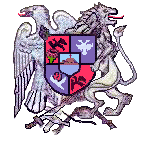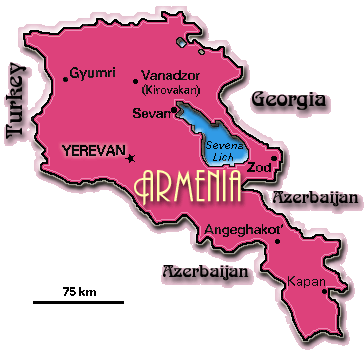Armenia



Geography
Location: Southwestern Asia, between Turkey and Azerbaijan
Area:
total area: 29,800 sq km
land area: 28,400 sq km
comparative area: slightly larger than MarylandLand boundaries: total 1,254 km, Azerbaijan (east) 566 km, Azerbaijan (south) 221 km, Georgia 164 km, Iran 35 km, Turkey 268 km
Coastline: 0 km (landlocked)
Maritime claims: none; landlocked
Armenian news
International disputes: violent and longstanding dispute with Azerbaijan over ethnically Armenian exclave of Nagorno-Karabakh; traditional demands on former Armenian lands in Turkey have greatly subsided
Climate: highland continental, hot summers, cold winters
Terrain: high Armenian Plateau with mountains; little forest land; fast flowing rivers; good soil in Aras River valley
Natural resources: small deposits of gold, copper, molybdenum, zinc, alumina
Land use:
arable land 17%
permanent crops 3%
meadows and pastures 20%
forest and woodland 0%
other 60%Irrigated land: 3,050 sq km (1990)
Environment:
current issues soil pollution from toxic chemicals such as DDT; energy blockade, the result of conflict with Azerbaijan, has led to deforestation as citizens scavenge for firewood; pollution of Hrazdan (Razdan) and Aras Rivers; the draining of Lake Sevan,a result of its use as a source for hydropower, threatens drinking water supplies; air pollution in Yerevan
natural hazards occasionally severe earthquakes (25,000 people killed in major quake in 1988); subject to drought
international agreements party to Biodiversity, Climate ChangeNote: landlocked
People
Population: 3,521,517 (July 1994 est.)
Population growth rate: 1.08% (1994 est.)
Birth rate: 24.21 births/1,000 population (1994 est.)
Death rate: 6.72 deaths/1,000 population (1994 est.)
Net migration rate: -6.72 migrant(s)/1,000 population (1994 est.)
Infant mortality rate: 27.1 deaths/1,000 live births (1994 est.)
Life expectancy at birth:
total population 72.07 years
male 68.65 years
female 75.65 years (1994 est.)Total fertility rate: 3.19 children born/woman (1994 est.)
Nationality:
noun Armenian(s)
adjective ArmenianEthnic divisions: Armenian 93%, Azeri 3%, Russian 2%, other 2%
Religions: Armenian Orthodox 94%
Languages: Armenian 96%, Russian 2%, other 2%
Literacy: age 9-49 can read and write (1970)
total population 100%
male 100%
female 100%Labor force: 1.578 million
by occupation
industry and construction 34%, agriculture and forestry 31%, other 35% (1992)
Government
Names:
conventional long form Republic of Armenia
conventional short form Armenia
local long form Hayastani Hanrapetut'yun
local short form Hayastan
former Armenian Soviet Socialist Republic; Armenian RepublicDigraph: AM
Type: republic
Capital: Yerevan
Administrative divisions: none (all rayons are under direct republic jurisdiction)
Independence: 28 May 1918 (First Armenian Republic); 23 September 1991 (from Soviet Union)
National holiday: Referendum Day, 21 September
Constitution: adopted NA April 1978; post-Soviet constitution not yet adopted
Legal system: based on civil law system
Suffrage: 18 years of age; universal
Executive branch:
chief of state President Levon Akopovich TER-PETROSYAN (since 16 October 1991), Vice President Gagik ARUTYUNYAN (since 16 October 1991); election last held 16 October 1991 (next to be held NA); results - Levon Akopovich TER-PETROSYAN 86%; radical nationalists about 7%; note - Levon Akopovich TER-PETROSYAN was elected Chairman of the Armenian Supreme Soviet 4 August 1990 before becoming president
head of government Prime Minister Hrant BAGRATYAN (since 16 February 1993); First Deputy Prime Minister Vigen CHITECHYAN (since 16 February 1993)
cabinet Council of Ministers; appointed by the presidentLegislative branch: unicameral
Supreme Soviet elections last held 20 May 1990 (next to be held NA); results - percent of vote by party NA; seats - (260 total) non-aligned 125, ANM 52, DPA 23, Democratic Liberal Party 17, ARF 17, NDU 9, Christian Democratic Party 1, Constitutional Rights Union 1, UNSD 1, Republican Party 1, Nagorno-Karabakh representatives 13Judicial branch: Supreme Court
Political parties and leaders: Armenian National Movement (ANM), Ter-Husik LAZARYAN, chairman; National Democratic Union (NDU), David VARTANYAN, chairman; Armenian Revolutionary Federation (ARF, Dashnaktsutyun), Arutyun ALISTAKESYAN, chairman; Democratic Party of Armenia (DPA; Communist Party), Aram SARKISYAN, chairman; Christian Democratic Party, Azat ARSHAKYAN, chairman; Greens Party, Hakob SANASARIAN, chairman; Democratic Liberal Party, Rouben MIRZAKHANYAN, chairman; Republican Party, Ashot NAVARSARDYAN, chairman; Union for Self-Determination (UNSD), Paruir AIRIKYAN, chairman
Member of: BSEC, CCC, CIS, CSCE, EBRD, ECE, IAEA, IBRD, ICAO, IDA, IFAD, ILO, IMF, INTELSAT, INTERPOL, IOC, ITU, NACC, NAM (observer), UN, UNCTAD, UNESCO, UNIDO, UPU, WHO, WIPO, WMO
Diplomatic representation in US:
chief of mission Ambassador Rouben Robert SHUGARIAN
chancery Suite 210, 1660 L Street NW, Washington, DC 20036
telephone (202) 628-5766US diplomatic representation:
chief of mission Ambassador Harry J. GILMORE
embassy 18 Gen Bagramian, Yerevan
mailing address use embassy street address
telephone 7-8852-151-144 or 8852-524-661
FAX 7-8852-151-138
Economy
BISNIS Economic ReviewOverview: Under the old central planning system, Armenia had built up a developed industrial sector, supplying machine building equipment, textiles, and other manufactured goods to sister republics in exchange for raw materials and energy resources. Armenia is a large food importer and its mineral deposits (gold, bauxite) are small. The economic decline in the past three years (1991-93) has been particularly severe due to the ongoing conflict over the Armenian enclave of Nagorno-Karabakh in Azerbaijan. Azerbaijan and Turkey have blockaded pipeline and railroad traffic to Armenia for its support of the Karabakh Armenians. This has left Armenia with only sporadic deliveries of natural gas through unstable Georgia, while other fuel and raw materials are in critical short supply. Inflation, roughly 14% per month in the first nine months of 1993, surged even higher in the fourth quarter. In late 1993, most industrial enterprises were either shut down or operating at drastically reduced levels. Only small quantities of food were available (mostly humanitarian aid), heat was nonexistent, and electricity strictly rationed. An economic recovery cannot be expected until the Nagorno-Karabakh conflict is settled and until transportation through Georgia improves.
National product: GDP - purchasing power equivalent - $7.1 billion (1993 estimate from the UN International Comparison Program, as extended to 1991 and published in the World Bank's World Development Report 1993; and as extrapolated to 1993 using official Armenian statistics, which are very uncertain because of major economic changes since 1990)
National product real growth rate: -9.9% (1993 est.)
National product per capita: $2,040 (1993 est.)
Inflation rate (consumer prices): 14% per month average (first 9 months, 1993)
Unemployment rate: 6.5% of officially registered unemployed but large numbers of underemployed (1993 est.)
Budget:
revenues $NA
expenditures $NA, including capital expenditures of $NAExports: $31 million to countries outside the FSU (f.o.b., 1993)
commodities machinery and transport equipment, light industrial products, processed food items, alcoholic products (1991)
partners NAImports: $87 million from countries outside the FSU (c.i.f., 1993)
commodities grain, other foods, fuel, other energy (1991)
partners Russia, US, ECExternal debt: $NA
Industrial production: growth rate -11% (1993 est.)
Electricity:
capacity 2,875,000 kW production 9 billion kWh
consumption per capita 2,585 kWh (1992)Industries: traditionally diverse, including (as a percent of output of former USSR) metalcutting machine tools (5.5%), forging-pressing machines (1.9%), electric motors (9%), tires (1.5%), knitted wear (4.4%), hosiery (3.0%), shoes (2.2%), silk fabric (0.8%), washing machines (2.0%), chemicals, trucks, watches, instruments, and microelectronics (1990); currently, much of industry is shut down
Agriculture: accounts for about 45% of GDP; only 17% of land area is arable; employs 20%-30% of labor force as residents increasingly turn to subsistence agriculture; fruits (especially grapes) and vegetable farming, minor livestock sector; vineyards near Yerevan are famous for brandy and other liqueurs
Illicit drugs: illicit cultivator of cannabis mostly for domestic consumption; used as a transshipment point for illicit drugs to Western Europe
Economic aid: recipient of considerable humanitarian aid, mostly food and energy products, from US and EC; Russia has granted 60 billion rubles in technical credits
Currency: 1 dram = 100 luma; introduced separate currency in November 1993
Exchange rates: NA
Fiscal year: calendar year
Communications
Railroads: 840 km; does not include industrial lines (1990)
Highways:
total 11,300 km
paved 10,500 km
unpaved earth 800 km (1990)Inland waterways: NA km
Pipelines: natural gas 900 km (1991)
Ports: none; landlocked
Airports:
total 12
usable 10 with permanent-surface runways 6
with runways over 3,659 m 1 with runways 2,440-3,659 m 3
with runways 1,060-2,439 m 2
note a C-130 can land on a 1,060-m airstripTelecommunications: progress on installation of fiber optic cable and construction of facilities for mobile cellular phone service remains in the negotiation phase for joint venture agreement; Armenia has about 650,000 telephones; average telephone density is 17.7 per 100 persons; international connections to other former republics of the USSR are by landline or microwave and to other countries by satellite and by leased connection through the Moscow international gateway switch; broadcast stations - 100% of population receives Armenian and Russian TV programs; satellite earth station - INTELSAT
Defense Forces
Branches: Army, Air Force, National Guard, Security Forces (internal and border troops)
Manpower availability: males age 15-49 862,921; fit for military service 690,113; reach military age (18) annually 28,458 (1994 est.)
Defense expenditures: 250 million rubles, NA% of GDP (1992 est.); note - conversion of the military budget into US dollars using the current exchange rate could produce misleading results
CIA World Facts (1994)
This page was last up-dated: